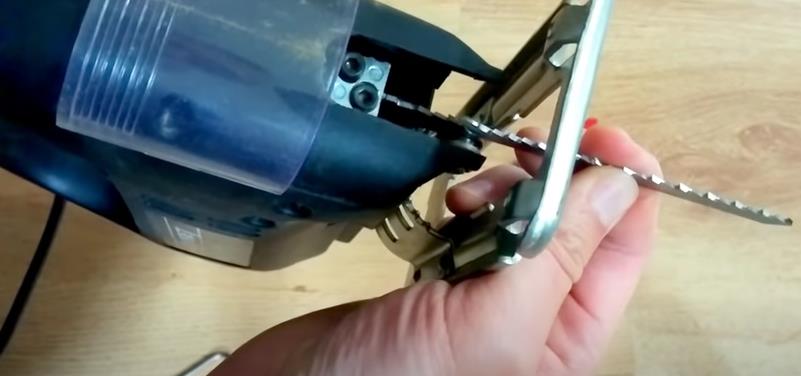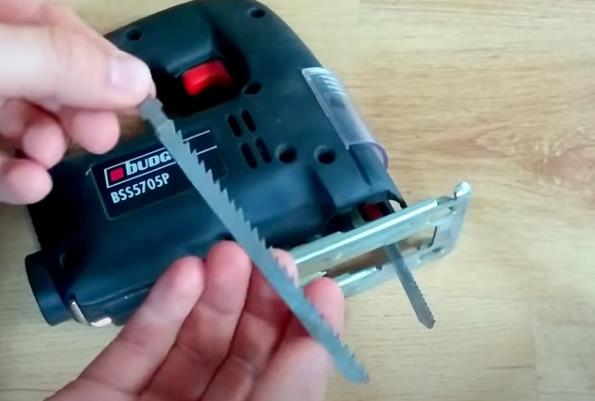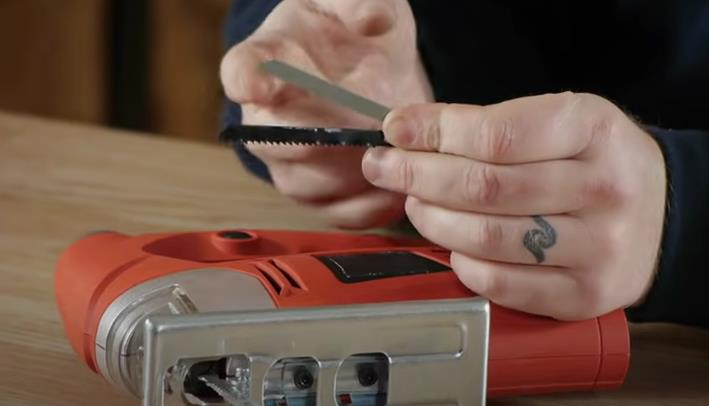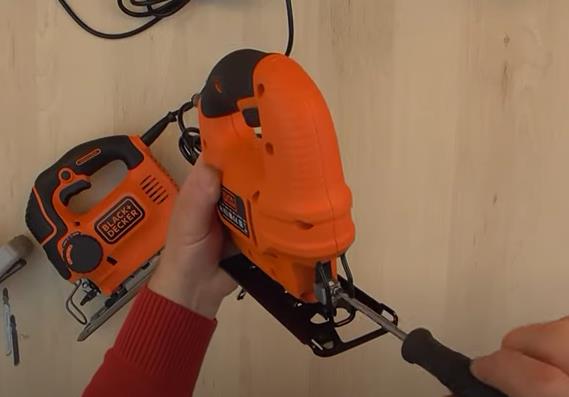To change a jigsaw blade, remove the old blade and insert a new one in the blade holder.
A jigsaw is a versatile power tool that can cut various materials. Keep the jigsaw running smoothly, and the blade should be changed regularly. A dull or damaged blade can cause uneven cuts and even harm the tool. You can now think about how to change a jigsaw blade.
It may appear challenging to change a jigsaw blade, but it is a straightforward procedure. To change a jigsaw blade, you don’t need to be an expert woodworker; anyone with a few tools and patience can do it.
This post will explain how to change a jigsaw blade and give you some tips. Whether you use your jigsaw for DIY projects or professional work, knowing how to change the blade is critical to keeping your equipment running correctly.
Jigsaw Blades Explained
Before we get into how to change a jigsaw blade, it’s essential to understand the many types of blades available. Jigsaw blades are available in various sizes, shapes, and tooth combinations to meet a wide range of cutting applications.
The following are the most popular types of blades:
- Wood blades: These blades are specifically designed for cutting wood and include teeth positioned at an angle to avoid splintering.
- Metal blades: As the name implies, these blades are intended for metal cutting. They have teeth that are closer together to avoid heat accumulation and protect the blade when cutting through hard materials.
- Multi-material blades: These blades are intended for usage on a wide range of materials, including wood, metal, and plastic. They feature teeth placed at various angles to suit various cutting purposes.
How To Change A Jigsaw Blade?

A jigsaw is an essential tool in the workshop, and it’s important to have a sharp blade to get the best results. A dull blade can not only make cutting difficult but also pose a safety risk.
Lets will show you how to change a jigsaw blade with step-by-step instructions.
Step-1: Safety Precautions
Before starting the process of changing the blade, it’s important to take certain safety precautions. These include:
- Unplugging the jigsaw from the power source
- Wearing protective gloves and eyewear
- Making sure the tool is securely clamped to a work surface
Step-2: Gather a Few Tools
You will need a few basic tools to change the jigsaw blade, including:
- A new blade
- A screwdriver
- A wrench (if your jigsaw requires one)
Step-3: Release The Blade Clamp
The blade clamp must then be released. This is the mechanism that keeps the jigsaw blade in place. The blade clamp’s location varies depending on the manufacturer and type of the jigsaw, but it is normally around the base of the blade.
Consult the instructions for your jigsaw to determine the precise location of the blade clamp and the release mechanism. Some jigsaws require the use of a screwdriver, while others demand the use of a wrench.
Step-4: Discard The Old Blade
Once the blade clamp has been unlocked, you can remove the old blade from the jigsaw. Simply remove the blade from the clamp. If the blade is extremely obstinate, jiggle it a little to free it.
Step-5: Insert The New Blade
After removing the old blade, place the new blade into the jigsaw. Check that the blade’s teeth are pointing in the direction of the cut. Insert the blade into the clamp and tighten it until it is securely in place.
Step-6: Put The Blade To The Test
Once the blade is securely in place, connect the jigsaw to the power source and test it to ensure it is cutting properly. If so, you’re good to go. If not, ensure the blade is correctly fastened, and the teeth point in the right direction.
Now that you know how to change a jigsaw blade, you’re ready to tackle any project, no matter how big or small. So get out there and start sawing with a new and sharp blade.
What Is The Best Way To Change A Jigsaw Blade?
Use a saw blade changing tool to remove the old blade and insert a new one.

If you’ve ever tried to change a jigsaw blade, you know it can be a real pain. The blade is usually stuck in there, and it’s hard to get a good grip on it.
Here’s a step-by-step guide to changing a jigsaw blade the easy and short way:
- Unplug the jigsaw and make sure it’s not plugged into an outlet.
- Use a small screwdriver to loosen the screw that holds the blade in place.
- Carefully remove the old blade and insert the new blade.
- Tighten the screw to hold the new blade in place.
- Plug the jigsaw back in, and you’re ready to go.
Here’s a quick tip: If the new blade is too tight, try loosening the screw a little bit. This will help the blade slide into place more easily.
Why Do You Need To Change A Jigsaw Blade?

The jigsaw blades can become dull over time, making it difficult to cut through materials. If you notice that your jigsaw is struggling to cut cleanly, or if you have to apply more pressure than usual, it is probably time to change the blade.
Another reason to change a jigsaw blade is if it becomes damaged. The blade can become bent or broken if you hit a nail or other hard object while cutting. In this case, you will need to replace the blade before you can continue cutting.
How Often Should You Change Your Jigsaw Blade?
A blade should be changed when it becomes dull.
Jigsaw blades are one of the most important parts of your jigsaw, and it is important to keep them in good condition. Depending on how often you use your jigsaw, you should change the blade every few months.
If you use your jigsaw frequently, you will need to change the blade more often. A good rule of thumb is to change the blade every time you change the oil in your car. For most people, this is about every 3,000 miles.
If you use your jigsaw infrequently, you can get away with changing the blade less often. A good rule of thumb is to change the blade every time you use the jigsaw for a big project. For most people, this is about every 6 months.
No matter how often you use your jigsaw, it is important to inspect the blade regularly. If you notice the blade is getting dull, it is time to change it. A dull blade will not only make your jigsaw harder to use, but it can also damage your workpiece.
When changing the blade on your jigsaw, always be sure to follow the manufacturer’s instructions. Different jigsaws have different ways of changing the blade, and you don’t want to damage your jigsaw by doing it wrong.
If you’re unsure how to change the blade on your jigsaw, take it to a qualified repair person. They will be able to change the blade for you and show you how to do it properly.
Tips for Maintaining Your Jigsaw Blade

Taking proper care of your jigsaw is critical to getting the most out of it and extending the blades’ life. Here are a few pointers to remember:
- Properly store the blades: Keep your blades in a secure location where they will not be damaged. Keep them away from moisture, heat, and dust.
- Clean the blades regularly: After each usage, clean the blades to remove any sawdust or dirt. This will protect the blades from rust and increase their life.
- Use the right blade for the job: Different materials necessitate the use of different blades. Choose the appropriate blade for your cutting material to guarantee a clean and exact cut.
- Inspect the blades before use: Before using the blades, please make the following checks: Before each use, inspect the blades to ensure they are in good condition. Replace the blade immediately if you find any cracks or chips.
Common Mistakes to Avoid When Changing a Jigsaw Blade
When changing a jigsaw blade, there are several common mistakes that you should avoid to ensure a safe and successful blade change:
- Not wearing protective gloves: Always wear gloves to protect your hands from cuts and injuries while handling the jigsaw and blades.
- Not unplugging the jigsaw: Always unplug the jigsaw before changing the blade to avoid any accidental start-ups.
- Using the wrong type of blade: Make sure to choose the right type of blade for your jigsaw and the material you are cutting. Using the wrong blade can lead to breakage, poor cuts, and increased vibration.
- Not tightening the blade enough: Make sure to tighten the blade securely to prevent it from slipping or falling out during use.
- Forcing the blade: Don’t force the blade into place if it’s not fitting properly. This can cause damage to the jigsaw and the blade.
- Not checking the blade orientation: Ensure the blade is oriented in the correct direction before tightening it.
- Not cleaning the blade or blade holder: Clean the blade and the blade holder before inserting a new blade to remove any debris or rust that could interfere with a proper blade change.
By avoiding these common mistakes, you can ensure a safe and successful jigsaw blade change and avoid potential problems while using your jigsaw.
That’s all there is to it! Now you know how to change a jigsaw blade, so you can always have the right one for the job.
FAQ
What Type Of Jigsaw Blade Should You Use For Different Materials?
There are different types of jigsaw blades available for different types of materials. For example, a blade with a coarse tooth count is good for cutting softwoods, while a blade with a fine tooth count is better for cutting hardwoods. If you’re cutting metals, you’ll need a blade designed specifically for that purpose.
What Are Some Tips For Changing A Jigsaw Blade?
There are a few things to keep in mind when changing a jigsaw blade:
1. Make sure the new blade is the right size and type for your jigsaw.
2. Be careful not to touch the sharp edges of the blade.
3. Insert the blade into the jigsaw so that the teeth are pointing downwards.
4. Tighten the blade securely so that it doesn’t come loose during use.
How Do You Know When It’s Time To Change Your Jigsaw Blade?
When the jigsaw blade becomes dull, it will no longer cut through the material as easily. You may have to apply more pressure to the jigsaw or the blade may start to skip over the surface of the material. If the blade becomes damaged, it can start to break apart and will need to be replaced.
How Can You Prolong The Life Of Your Jigsaw Blade?
To prolong the life of a jigsaw blade, it is important to use the correct type of blade for the material being cut, to avoid excessive heat build-up, and to keep the blade clean and sharp.
What Are Some Common Mistakes People Make When Changing A Jigsaw Blade?
Some common mistakes people make when changing a jigsaw blade include not disconnecting the power first, not using the proper tools, and not being careful.
Final Words
Changing a jigsaw blade is a quick and easy process that can be done with just a few basic tools. By following these step-by-step instructions, you can ensure that your jigsaw is always ready for use.
Additionally, it’s important to store your jigsaw blades properly to prolong their lifespan. When changing the blade, don’t forget to wear protective gear to keep yourself safe.
In conclusion, a sharp jigsaw blade is crucial for making precise cuts and ensuring safety. By following these simple steps, you can easily change the blade on your jigsaw. With a sharp blade, you can tackle any cutting project with confidence.
I hope that this has cleared up your doubt about how to change a jigsaw blade. Thank you for reading on.



